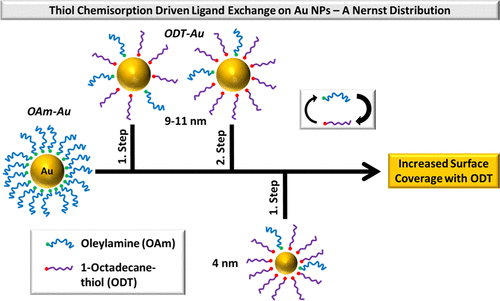Our official English website, www.x-mol.net, welcomes your feedback! (Note: you will need to create a separate account there.)
Monitoring Thiol–Ligand Exchange on Au Nanoparticle Surfaces
Langmuir ( IF 3.9 ) Pub Date : 2018-01-19 00:00:00 , DOI: 10.1021/acs.langmuir.7b04015 Martin Kluenker 1 , Mihail Mondeshki 1 , Muhammad Nawaz Tahir 1, 2 , Wolfgang Tremel 1
Langmuir ( IF 3.9 ) Pub Date : 2018-01-19 00:00:00 , DOI: 10.1021/acs.langmuir.7b04015 Martin Kluenker 1 , Mihail Mondeshki 1 , Muhammad Nawaz Tahir 1, 2 , Wolfgang Tremel 1
Affiliation

|
Surface functionalization of nanoparticles (NPs) plays a crucial role in particle solubility and reactivity. It is vital for particle nucleation and growth as well as for catalysis. This raises the quest for functionalization efficiency and new approaches to probe the degree of surface coverage. We present an (in situ) proton nuclear magnetic resonance (1H NMR) study on the ligand exchange of oleylamine by 1-octadecanethiol as a function of the particle size and repeated functionalization on Au NPs. Ligand exchange is an equilibrium reaction associated with Nernst distribution, which often leads to incomplete surface functionalization following “standard” literature protocols. Here, we show that the surface coverage with the ligand depends on the (i) repeated exchange reactions with large ligand excess, (ii) size of NPs, that is, the surface curvature and reactivity, and (iii) molecular size of the ligand. As resonance shifts and extensive line broadening during and after the ligand exchange impede the evaluation of 1H NMR spectra, one- and two-dimensional 19F NMR techniques (correlation spectroscopy and diffusion ordered spectroscopy) with 1H,1H,2H,2H-perfluorodecanthiol as the fluorinated thiol ligand were employed to study the reactions. The enhanced resolution associated with the spectral range of the 19F nucleus allowed carrying out a site-specific study of thiol chemisorption. The widths and shifts of the resonance signals of the different fluorinated carbon moieties were correlated with the distance to the thiol anchor group. In addition, the diffusion analysis revealed that moieties closer to the NP surface are characterized by a broader diffusion coefficient distribution as well as slower diffusion.
中文翻译:

监测金纳米颗粒表面上的硫醇-配体交换
纳米粒子(NPs)的表面功能化在粒子溶解度和反应性中起着至关重要的作用。它对于颗粒成核和生长以及催化至关重要。这引发了对功能化效率的探索,并提出了探索表面覆盖程度的新方法。我们提出了(原位)质子核磁共振(1H NMR)研究1-十八烷硫醇对油胺的配体交换与粒径的关系以及在Au NPs上的重复官能化作用。配体交换是一种与能斯特分布相关的平衡反应,这通常会导致遵循“标准”文献协议的表面功能化不完整。在这里,我们表明配体的表面覆盖率取决于(i)配体过量过多的重复交换反应,(ii)NP的大小,即表面曲率和反应性,以及(iii)配体的分子大小。由于在配体交换期间和之后共振位移和广泛的谱线加宽阻碍了1 H NMR光谱的评估,因此一维和二维19用1 H,1 H,2 H,2 H-全氟癸癸醇作为氟化硫醇配体的F NMR技术(相关光谱和扩散有序光谱法)研究了反应。与19 F核的光谱范围相关的增强的分辨率允许进行巯基化学吸附的位点特异性研究。不同氟化碳部分的共振信号的宽度和位移与到硫醇锚定基团的距离相关。另外,扩散分析表明,更接近NP表面的部分的特征在于较宽的扩散系数分布以及较慢的扩散。
更新日期:2018-01-19
中文翻译:

监测金纳米颗粒表面上的硫醇-配体交换
纳米粒子(NPs)的表面功能化在粒子溶解度和反应性中起着至关重要的作用。它对于颗粒成核和生长以及催化至关重要。这引发了对功能化效率的探索,并提出了探索表面覆盖程度的新方法。我们提出了(原位)质子核磁共振(1H NMR)研究1-十八烷硫醇对油胺的配体交换与粒径的关系以及在Au NPs上的重复官能化作用。配体交换是一种与能斯特分布相关的平衡反应,这通常会导致遵循“标准”文献协议的表面功能化不完整。在这里,我们表明配体的表面覆盖率取决于(i)配体过量过多的重复交换反应,(ii)NP的大小,即表面曲率和反应性,以及(iii)配体的分子大小。由于在配体交换期间和之后共振位移和广泛的谱线加宽阻碍了1 H NMR光谱的评估,因此一维和二维19用1 H,1 H,2 H,2 H-全氟癸癸醇作为氟化硫醇配体的F NMR技术(相关光谱和扩散有序光谱法)研究了反应。与19 F核的光谱范围相关的增强的分辨率允许进行巯基化学吸附的位点特异性研究。不同氟化碳部分的共振信号的宽度和位移与到硫醇锚定基团的距离相关。另外,扩散分析表明,更接近NP表面的部分的特征在于较宽的扩散系数分布以及较慢的扩散。


























 京公网安备 11010802027423号
京公网安备 11010802027423号